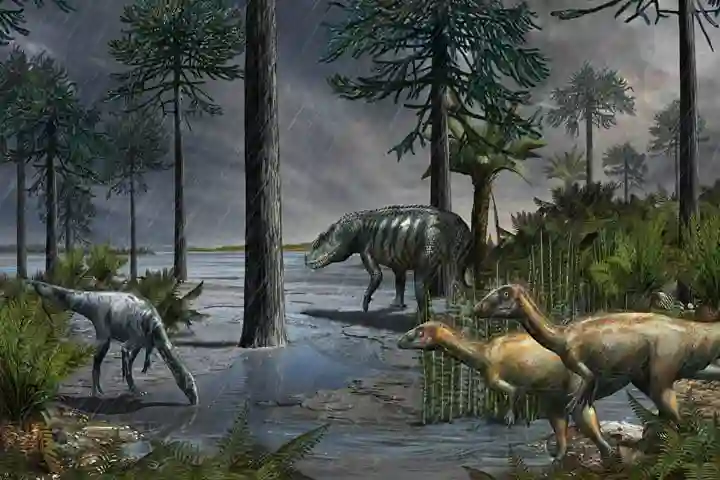Just like the cataclysmic event — the impact of an asteroid 66 million years ago — wiped out the dinosaurs from the face of the earth, another upheaval helped their rise to dominance on the planet.
According to an article in sciencenews.org, a new study suggests that the small sized beasts, moment to emerge came when volcanic activity in four major pulses resulted in climate change, which caused a two-million-year-long rainy spell.
Details of the study published in the Proceedings of the National Academy of Sciences this month have discovered evidence that was found buried deep underneath an ancient lake basin in China. These tie the emission of the volcanoes with changes in the environment and climate that generated a humid and hot oasis in the Triassic Period which was hot and dry.
Also read: Ancient ostrich eggshells dug up in South Africa shed light on climate change
In this brief geological period 234 million to 232 million years ago – called the Carnian Pluvial Episode – the dinosaurs evolved into big and strong and varied forms to rule the world for the coming 166 million years.
According to Jason Hilton, a paleobotanist at England’s University of Birmingham, earlier study had found the jump in world temperatures, rainfall and humidity during the period while also noted the change which took place in life on land and sea, yet it did delve on the causes of these changes.
This made Hilton and his colleagues look for answers in the core of sediments of lake-bottom taken from Jiyuan Basin. Interestingly, what they found is that the core had four distinct layers which also consisted of volcanic ash dated by the team to be between 234 and 232 million years ago and thus matching the timing of the Carnian Pluvial Episode. Mercury too was detected in those layers – representing volcanic eruptions.
Remarking on this aspect Hilton said: “Mercury entered the lake from a mix of atmospheric pollution, volcanic ash and also being washed in from surrounding land that had elevated levels of mercury from volcanism.”
Evidence was also garnered for linking volcanic eruption and change in environment during the Episode phase from the varied carbon types found in the layers – thus proving the release of carbon dioxide on four occasions. Another corroboration came through when change in pollens and microfossils was observed from those species who preferred drier climates to those who sought humid and warm climates.
Co-author of the study Jacopo Dal Corso, geologist at the University of Leeds in England drew the picture comprehensively as he explained that huge volumes of CO2 were released in the atmosphere by the volcanic pulses thereby increasing the temperatures and escalating the hydrologic cycle leading to increasing rainfall and also runoff into lakes. Simultaneously, there was evolution and proliferation of terrestrial plants with those preferring humidity. Wet environs due to rain gave a fillip to turtles, large amphibians called metoposaurids and dinosaurs.
Dal Corso stated that the Carnian Pluvial Episode was actually four distinct pulses of significant environmental change — each triggered by massive volcanic eruptions.
Also read: The strange case of a dinosaur species which reduced in size and fed on termites!
Further the data of mercury and carbon taken together suggested that the mercury came from a “major source of volcanism that was capable of impacting the global carbon cycle” and not local eruptions, said the researchers. The likely place where the volcanism came from was Wrangellia Large Igneous Province – present day British Columbia and Alaska.
Sharing his thoughts on this aspect, Andrea Marzoli, an igneous petrologist at Italy's University of Padua said that the study marks for the “first time that mercury and carbon isotope data are so well correlated across the Carnian Pluvial Episode”. Marzoli, who has studied Wrangellia but was not part of the study added: “The authors make a strong argument in favour of volcanically induced global climate change pulses.”
Having said that he noted: “The link to Wrangellia is still weak, simply because we don’t know the age of Wrangellia.”
Forensic geologist at Queen’s University Belfast in Ireland, Alastair Ruffell, who was not involved with the research said that more terrestrial records of the Carnian Pluvial Episode are needed, to “understand what this actually looked like on the ground.”




















